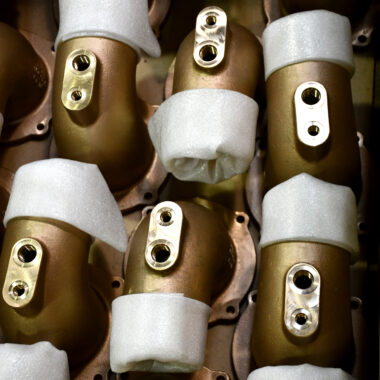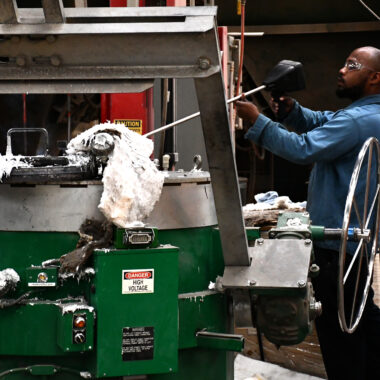Revealing the Artistry: Recognizing About Aluminum Casting
Wiki Article
Crafting Excellence: How to Accomplish High-Quality Light Weight Aluminum Castings Every Time
In the world of aluminum casting, the search of excellence is a constant journey that calls for a thorough strategy and a keen understanding of the complexities involved. Attaining constant premium aluminum spreadings requires an extensive understanding of the procedures, from selecting the ideal alloy to carrying out accurate mold and mildew layouts and diligently managing spreading specifications. However, the real mastery depends on the capability to implement these elements flawlessly to produce remarkable castings every single time. As we explore the ins and outs of crafting excellence in aluminum spreadings, uncovering the crucial strategies and methods that lead to flawless outcomes becomes vital for those pursuing excellence in this customized field.Understanding Aluminum Casting Processes
Aluminum casting processes, vital in the production sector, entail the detailed makeover of liquified light weight aluminum right into strong kinds via a collection of meticulously controlled actions. Understanding these processes is paramount to achieving top quality aluminum castings consistently - about aluminum casting. The key approaches made use of in light weight aluminum spreading are pass away casting, sand casting, and investment spreading
Each of these processes has its advantages and is chosen based on elements like complexity, volume, and desired finish of the aluminum spreading. about aluminum casting. Understanding the intricacies of these methods is essential for producers aiming to produce top quality aluminum castings continually
Picking the Right Aluminum Alloy
Selecting the appropriate light weight aluminum alloy is an important decision in the manufacturing of high-grade light weight aluminum castings. The selection of alloy significantly impacts the residential or commercial properties and characteristics of the last product. Various aluminum alloys offer differing levels of stamina, corrosion resistance, machinability, and thermal conductivity. When picking an aluminum alloy for spreading, it is important to consider the details requirements of the application to make certain ideal efficiency.One of the most frequently made use of light weight aluminum alloys for spreading is A356 - about aluminum casting. For applications requiring this article high strength, 7075 aluminum alloy is a popular option due to its outstanding strength-to-weight ratio.
Along with mechanical properties, considerations such as cost, availability, and post-casting processes ought to also influence the selection of the right aluminum alloy. By carefully evaluating these factors, manufacturers can ensure the manufacturing of high-grade light weight aluminum spreadings that fulfill the wanted requirements.
Applying Appropriate Mold Design
Developing a reliable mold and mildew style is essential for ensuring the effective manufacturing of premium aluminum spreadings. Appropriate mold design plays a substantial function in achieving the wanted attributes of the end product. To implement an effective mold layout, aspects such as material circulation, cooling prices, and part geometry must be very carefully thought about.One key element of mold style is guaranteeing correct filling and solidification of the light weight aluminum within the mold dental caries. This involves making runner and gating systems that promote smooth metal circulation and avoid issues such as air entrapment or incomplete dental anchor filling. Additionally, integrating cooling networks right into the mold layout helps manage solidification rates and lower the risk of porosity or contraction defects.

Controlling Spreading Parameters

Ensuring Post-Casting Top Quality Checks
To preserve the high top quality of aluminum spreadings, comprehensive post-casting top quality checks are vital. After the spreading process is finished, it is essential to make certain that the final items meet the preferred specifications and requirements. Among the key quality checks entails inspecting the surface coating of the spreadings to identify any type of issues such as porosity, fractures, or surface area abnormalities. This aesthetic assessment is often supplemented by non-destructive screening approaches like ultrasonic testing or dye penetrant assessment to detect internal problems that might compromise the integrity of the casting.Dimensional precision is an additional critical aspect that must be verified throughout post-casting top quality checks. Dimensions of key dimensions and tolerances should be taken to validate that the spreadings comply with the called for specifications. Furthermore, mechanical residential properties such as firmness, tensile stamina, and effect resistance may need to be evaluated through product screening to make sure that the spreadings possess the required strength and durability for their desired application.
Verdict
In verdict, accomplishing top notch aluminum castings calls for a detailed understanding of the spreading processes, selecting the ideal alloy, making molds efficiently, controlling spreading specifications meticulously, and performing post-casting high quality checks vigilantly. By following these steps, producers can regularly create aluminum spreadings that meet the highest possible requirements of top quality and efficiency.Achieving regular top notch aluminum spreadings demands a thorough grasp of the procedures, from choosing the ideal alloy to carrying out precise mold and mildew designs and diligently controlling spreading parameters. The key methods made use of in aluminum casting are pass away casting, sand spreading, and investment casting.
Financial investment casting, likewise recognized as precision spreading, entails producing wax patterns that are covered in ceramic to form molds.Picking the appropriate aluminum alloy is an essential decision in the production of premium light weight aluminum castings.Making sure specific control over casting criteria is important for preserving uniformity and top quality in aluminum casting production.
Report this wiki page